Key takeaways:
- Understanding group dynamics involves recognizing the emotions and motivations driving interactions, which can transform conflict into collaboration.
- Effective communication and trust are crucial for fostering an inclusive environment where every voice is valued and participant engagement is maximized.
- Setting clear goals and nurturing inclusive discussions can significantly enhance a group’s cohesion and drive towards shared objectives.
- Addressing challenges such as power dynamics and miscommunication is essential for promoting equitable participation and maintaining focus on group goals.
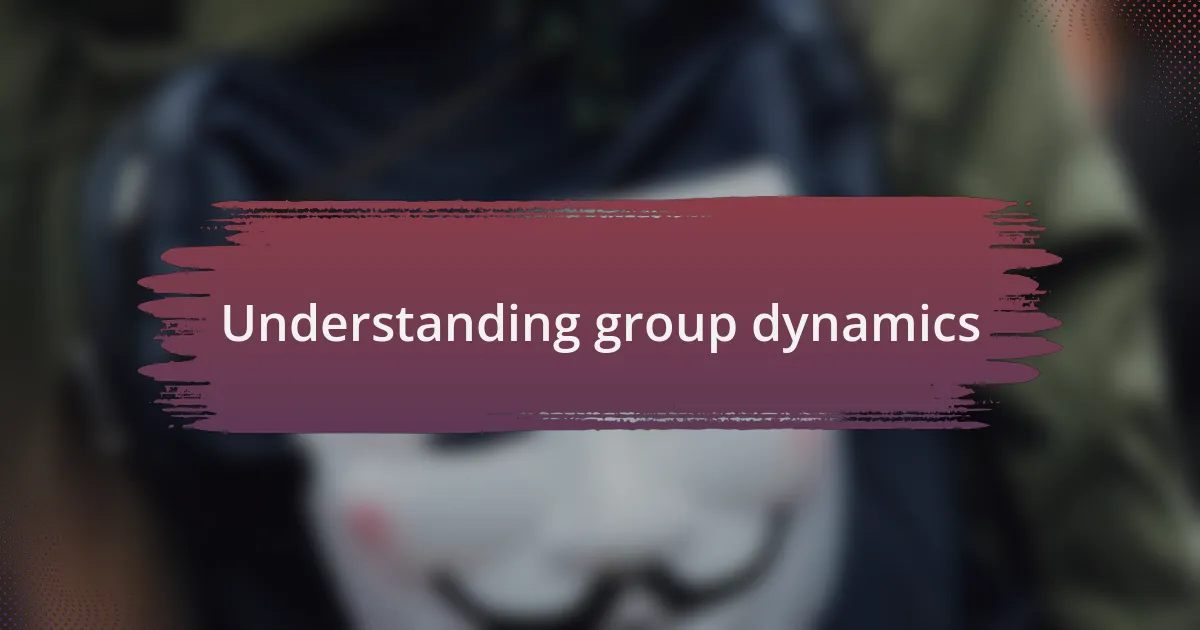
Understanding group dynamics
Understanding group dynamics goes beyond just observing how people interact; it’s about delving into the underlying motivations and emotions that drive those interactions. I remember a time during a community organizing meeting when tensions were high, and a simple misunderstanding could have derailed our efforts. Recognizing the emotions in the room helped me facilitate a discussion that transformed frustration into collaboration.
I often find myself pondering the question: what truly influences group behavior? In my experience, it’s a blend of individual personalities and shared goals that creates a dynamic environment. For instance, during a campaign, I noticed how leaders emerged based on their communication styles, shaping the group’s direction. The contrast between introverted and extroverted members revealed the importance of balance within the group.
There’s a unique energy in a group that can either lift or stifle the movement’s goals. I vividly recall a brainstorming session where an introverted member felt empowered to share his thoughts after a more dominant personality stepped back. It was a powerful reminder of how every voice matters and how understanding group dynamics can nurture inclusivity and foster a productive atmosphere.
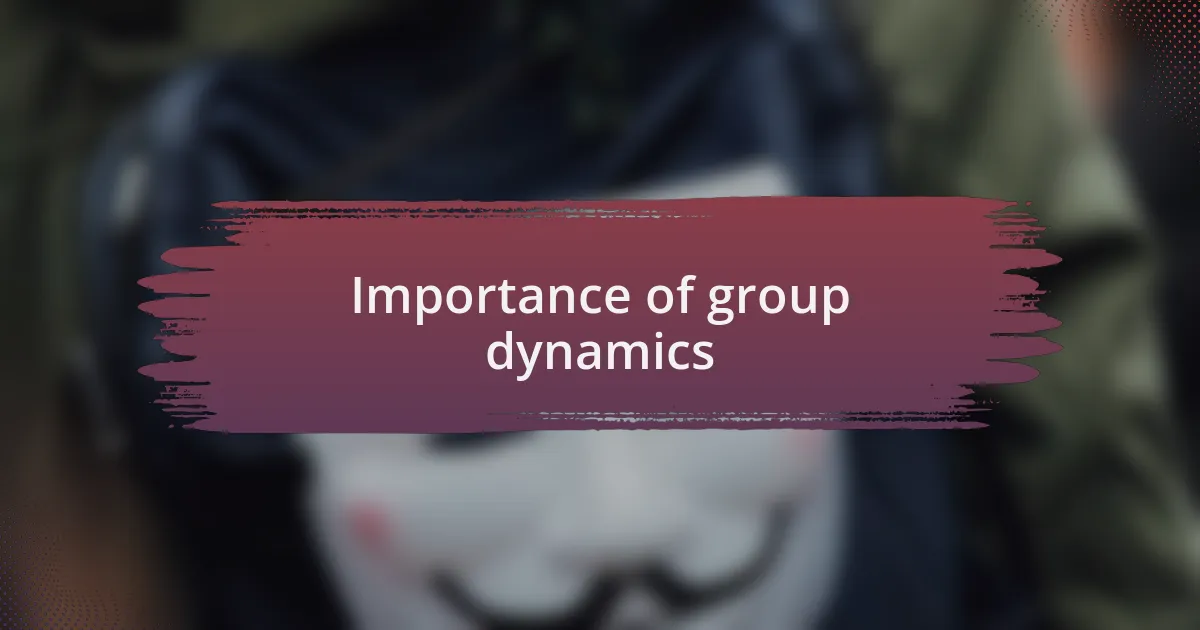
Importance of group dynamics
Reflecting on my experiences, I’ve come to realize that group dynamics can significantly influence a movement’s trajectory. I once participated in a protest planning committee where differing opinions ran rampant. The challenge was not just addressing the disagreements but understanding the emotions behind them. By creating an open space for dialogue, I witnessed how fear and excitement intertwined, ultimately transforming our discord into a united front.
Think of it this way: without addressing group dynamics, does a movement stand a chance? I remember being part of a discussion where two members clashed over strategy. Instead of letting tensions escalate, we took a step back and had each person express their underlying concerns. This simple act of listening unveiled common ground and helped us reach a consensus—highlighting that constructive conflict can propel a group forward.
Ultimately, the health of group dynamics is a reflection of its emotional environment. I fondly recall an instance when we celebrated a small victory; the atmosphere shifted from merely functional to genuinely euphoric. It was in those moments of connection that I understood the power of shared experiences and how they can fortify relationships within a group, reinforcing our commitment to the cause.
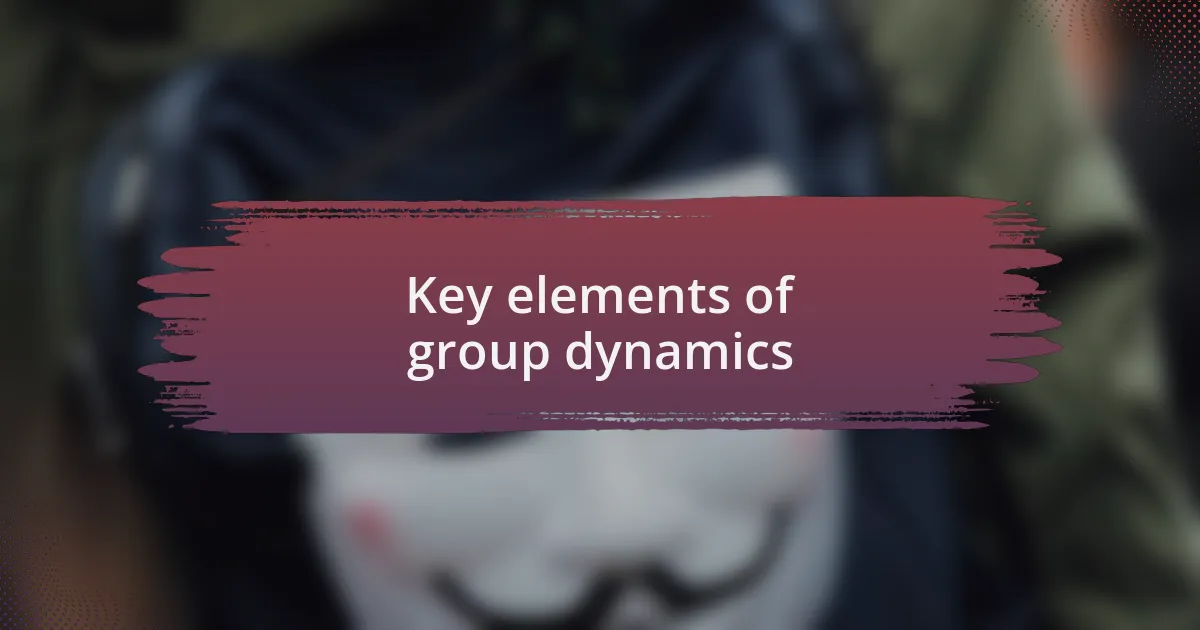
Key elements of group dynamics
Group dynamics hinge on several key elements that shape interactions and outcomes. One major factor is communication. I recall being at a strategy meeting where miscommunication became a barrier. When someone expected a direct response but received silence instead, it led to frustration. I learned that establishing clear channels for feedback can not only avoid misunderstandings but also foster an environment where everyone feels valued.
Another crucial element is trust. I’ve experienced moments where trust was lacking; in one meeting, hesitant members held back their ideas, fearing judgment. It made me realize how cultivating a safe space for sharing can result in more vibrant discussions. Asking open-ended questions, like “What do you think?” can be transformative. By actively encouraging participation, the group becomes more cohesive and innovative.
Finally, the roles individuals play within the group can steer the dynamics significantly. There was a time when I stepped into a leadership position purely by circumstance. Initially, I felt out of my depth, but once I embraced being a facilitator rather than just a decision-maker, I noticed a shift. I began to empower others to take charge of their strengths. Have you noticed how when people feel they have a purpose, their engagement skyrockets? It’s these small adjustments in recognizing roles that can elevate a group’s collective energy.
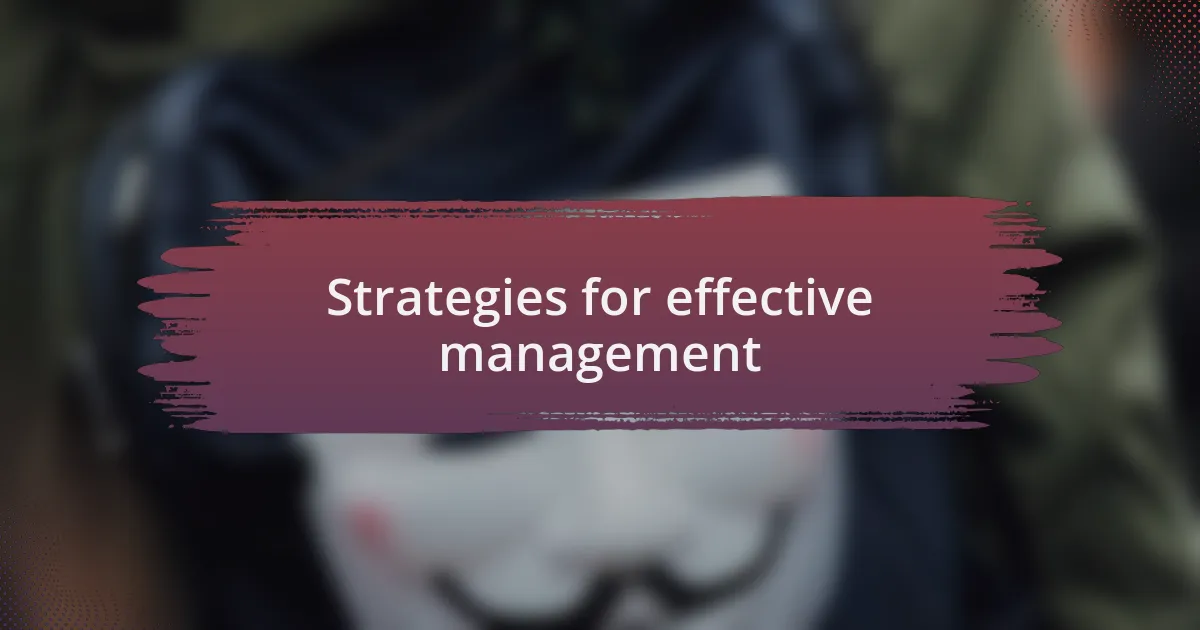
Strategies for effective management
To effectively manage group dynamics, I’ve found that setting clear goals can serve as a compass for the team. In one project, we gathered to brainstorm our objectives, and it became clear that we were all on different pages. Once we aligned our vision and articulated our shared goals, the energy in the room shifted. Have you ever experienced that moment when everyone suddenly sees the same path forward? It’s invigorating how a common purpose can galvanize a team, making each member more accountable and engaged.
Another strategy that has proven invaluable in my experience is nurturing inclusive discussions. During one particularly heated debate, I noticed some voices were overshadowed by more dominant personalities. Taking a step back, I implemented a round-robin format for sharing ideas. This simple change invited quieter members to contribute, sparking insightful perspectives that enriched our conversations. Have you ever considered how much untapped wisdom may lie in the quieter corners of your group? By creating space for diverse viewpoints, the group can innovate and evolve together.
Lastly, providing ongoing support and recognizing achievements is essential. I remember celebrating small wins during a long campaign—a simple acknowledgment of effort can do wonders. One team member expressed appreciation for this practice, mentioning how it made them feel connected and motivated. Why do we often overlook the power of recognition? Small gestures can significantly impact morale and reinforce a culture of collaboration, reminding everyone that their contributions matter.
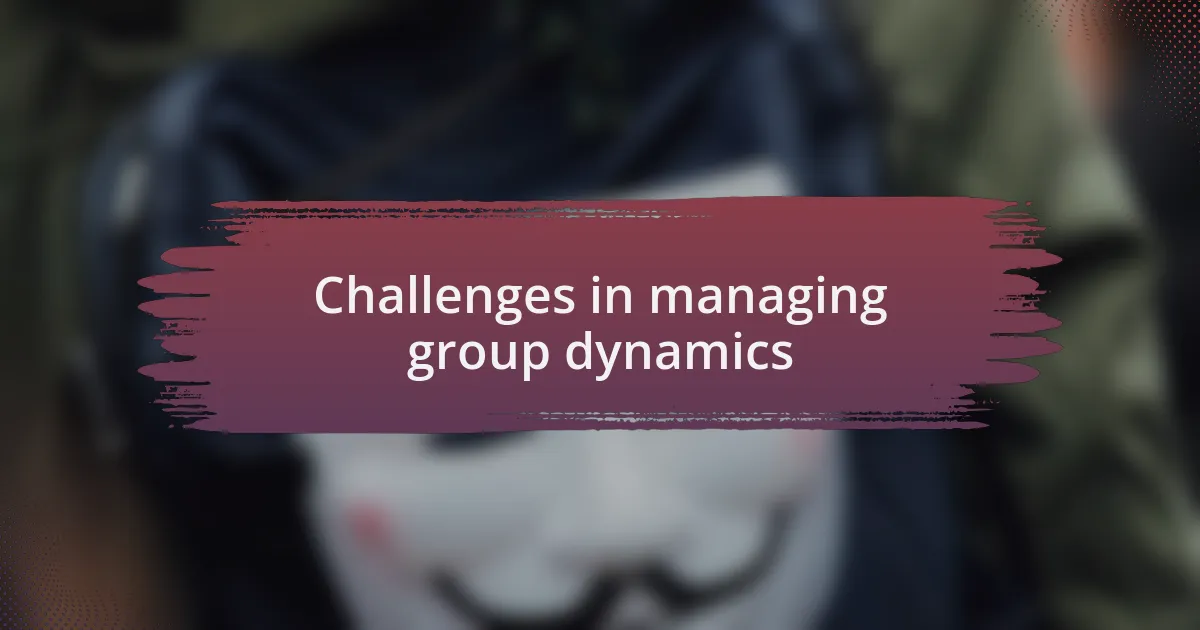
Challenges in managing group dynamics
Navigating group dynamics isn’t always smooth sailing; there are significant challenges that can arise. For instance, I recall a project where conflicting personalities clashed, hindering collaboration. It was frustrating to witness valuable ideas being drowned out by unnecessary drama. Have you ever felt the tension in a room so thick that it stifles creativity? It took deliberate intervention to redirect the focus back to our goals and foster a more constructive atmosphere.
Another common hurdle is miscommunication. I experienced this firsthand during a pivotal meeting when expectations were unclear, leading to a cascade of misunderstandings. It became evident that everyone had their interpretations of our objectives, which created confusion and frustration. How often do we assume everyone is on the same page, only to discover we are not? By implementing regular check-ins, we gradually cleared up confusion and aligned our efforts, reinforcing that communication is an ongoing necessity, not just a one-time event.
Lastly, power dynamics can complicate group interactions. In one instance, a member with a strong presence dominated discussions, unintentionally sidelining quieter team members. It’s disheartening to see potentially brilliant ideas go unspoken simply because of a few louder voices. Have you ever witnessed a meeting where only a handful of participants seemed to engage? Recognizing these dynamics is critical; it made me realize how important it is to create mechanisms for equitable participation, ensuring every voice has the chance to shine.
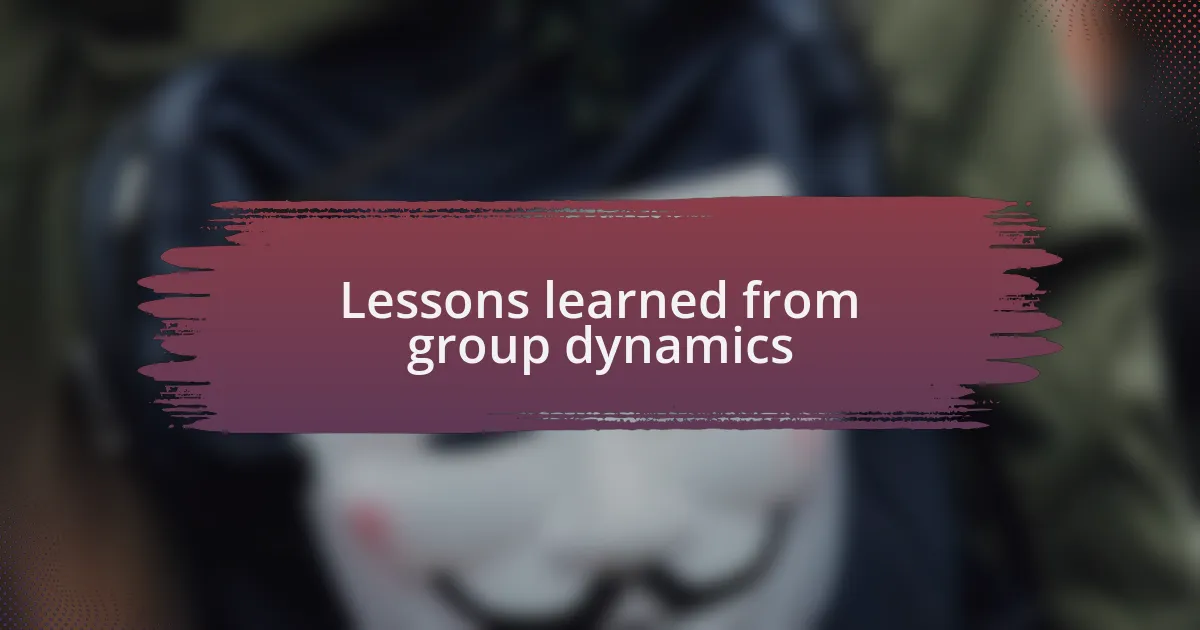
Lessons learned from group dynamics
Understanding group dynamics has taught me that fostering inclusivity is paramount. In one of my experiences, I organized an open forum where each member was encouraged to share their thoughts without interruptions. The result was not just a list of ideas, but a palpable shift in how we collaborated. Have you ever seen the transformation that occurs when everyone feels safe to express themselves? It’s remarkable how this simple adjustment can lead to innovative solutions emerging from unexpected voices.
Moreover, I learned the importance of adaptability in group interactions. I recall a situation where a planned approach didn’t resonate with the group, resulting in disengagement. It was a wake-up call for me. Instead of stubbornly sticking to our agenda, I decided to pivot and allow the group to shape the discussion. This responsive mindset not only revitalized the conversation but also empowered participants, forging a sense of ownership over the outcome. Isn’t it fascinating how flexibility can unlock a wealth of creativity?
Lastly, the value of reflection cannot be overstated. After completing a project, our team took time to discuss what worked and what didn’t. I was initially hesitant, thinking it might bring up sour feelings, but this retrospective created a trusting space for honest dialogue. Reflecting on our experiences didn’t just identify areas for improvement; it fostered solidarity among us. Have you ever found that looking back can guide you forward? It’s a lesson that continues to resonate deeply with me every time I engage with a group.